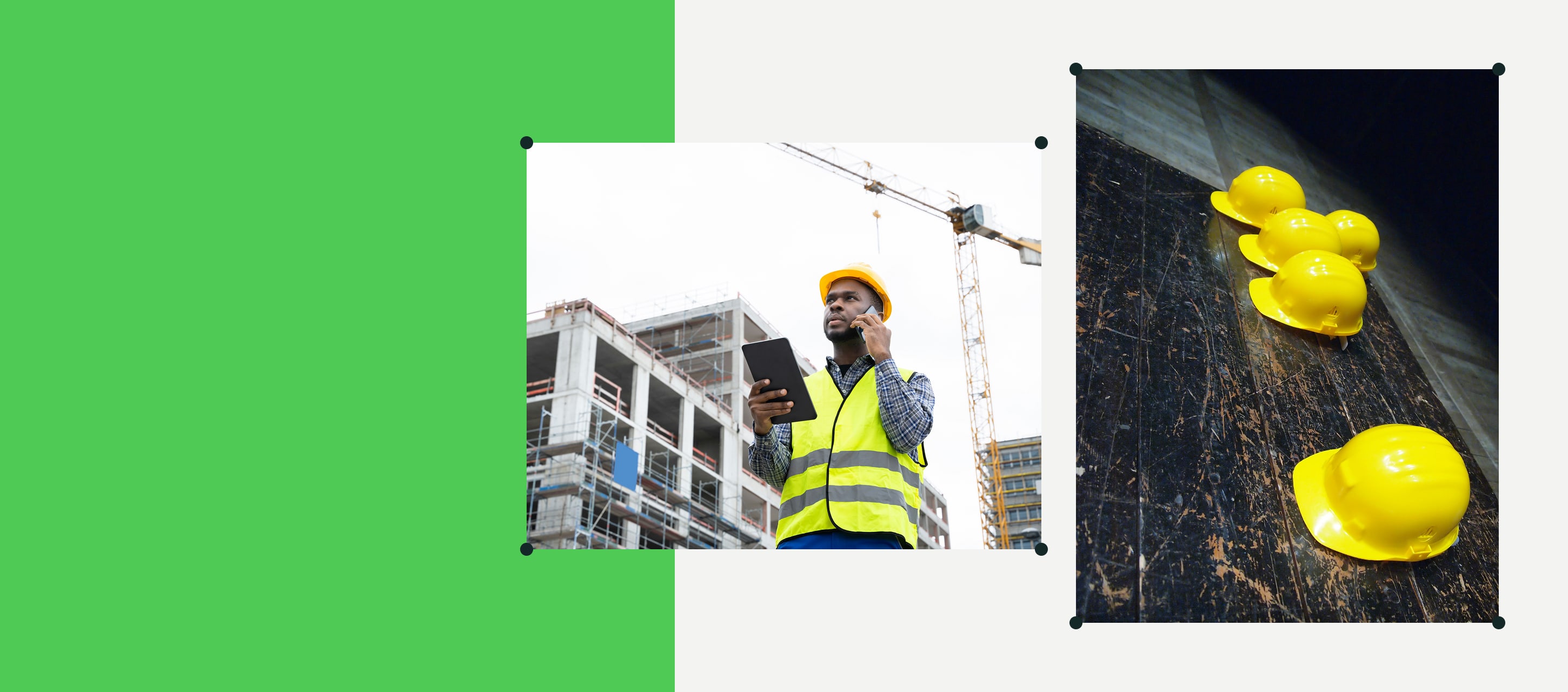Safety talks are a powerful way to discuss hazards and remind people about proper safety procedures. And the best part is that you can deliver them live or share pre-recorded sessions using software to conduct toolbox talks.
To make the choosing process easier, we’ve compiled a list of 100 safety talk ideas suitable for both formats.
Contents:
100 Quick Safety Talks Topics for Daily Meetings
This list isn’t exhaustive, but it’s a good starting point. Each topic includes a brief description of the problems it addresses and the key points covered. You don’t have to use all 100 of course – just pick the ones that best suit your working conditions and specific needs.
By the way, the topics are organized in alphabetical order, so that you can navigate faster.
- Accident Prevention: Focuses on understanding the causes of accidents, implementing preventative measures, and highlighting the financial and personal costs of accidents.
- Active Shooter Preparedness: Provides training on evacuation, lockdown, and communication strategies for emergencies.
- Active Shooter Preparedness Drills: Highlights the importance of regular drills to prepare employees for real-life active shooter scenarios.
- AED Usage: Provides training on operating automated external defibrillators during cardiac emergencies.
- Advanced PPE Technologies: Covers new advancements in personal protective equipment (PPE), such as wearable tech for monitoring worker safety.
- Aerial Lift Safety: Covers safe operation of aerial lifts, including harness use, load limits, and avoiding tip-overs.
- Air Quality Monitoring: Focuses on identifying and mitigating pollutants to ensure a healthy workspace.
- Alcohol Awareness: Discusses the impact of alcohol on workplace safety and performance.
- Allergic Reactions: Covers strategies to identify and mitigate allergens in the workplace.
- Amputations: Highlights risks and prevention strategies for avoiding severe injuries caused by machinery and equipment in industrial settings.
- Anger Management: Covers strategies to recognize, manage, and express anger constructively.
- Anonymous Reporting Systems: Encourages employees to report concerns and communicate effectively on safety without fear.
- Anti-Phishing Awareness: Educates employees on identifying and avoiding phishing scams to protect company data.
- Automated Safety Inspections: Discusses using software and mobile apps to streamline and improve the accuracy of site safety inspections in the field.
- Back Injury Prevention: Focuses on techniques and practices to avoid back injuries, including safe lifting and ergonomic workstations.
- Backing up Trucks and Equipment Safely: Highlights the risks of reversing large vehicles and equipment, emphasizing spotters, mirrors, and backup alarms.
- Battling Complacency: Addresses how routine work can lead to overlooking safety protocols and offers strategies to stay vigilant.
- Behavior-Based Safety Programs: Explains how observing and modifying worker behavior can reduce accidents and improve safety culture.
- Biohazard Safety: Explains the risks of exposure to biological materials and proper procedures for handling them.
- Building a Safety Culture: Promotes the importance of fostering a culture where safety is a shared value.
Read More Read More Top SafetyCulture alternatives for 2026 ops managers need to know
- Building Shaft and Open Holes: Discusses the dangers of unprotected openings in construction sites, emphasizing proper safety hazards in the workplace.
- Burn Safety: Discusses preventing and treating burns caused by fire, chemicals, or hot surfaces, with emphasis on PPE and proper handling techniques.
- Burnout Awareness and Prevention: Educates on recognizing signs of burnout and addressing its causes, such as workload imbalance and poor work-life integration.
- Carbon Monoxide Safety: Advises on installing CO detectors and maintaining equipment to reduce exposure.
- Chainsaws for Construction: Focuses on safe chainsaw operation, PPE requirements, and maintenance to prevent kickbacks and injuries.
- Chemical Spill Response: Provides guidelines for managing hazardous material spills safely.
- Chronic Health Conditions Management: Promotes understanding and support for employees managing conditions like asthma or diabetes.
- Circuit Breaker Safety: Teaches employees how to safely reset breakers and recognize overload warning signs.
- Cold Stress Hazards: Covers how to recognize and mitigate risks associated with working in cold weather conditions, including frostbite and hypothermia.
- Combustible Materials: Addresses the safe handling, storage, and potential ignition sources of flammable materials to prevent workplace fires.
- Concrete Pumping: Discusses safety precautions for operating concrete pumps, including preventing hose whip, proper PPE, and equipment maintenance.
- Construction Crane Operations: Focuses on advanced crane safety measures, including remote operation and sensor-based monitoring systems.
- Construction Pollution Prevention: Explores strategies to minimize environmental impacts from construction activities, such as dust control, waste management, and runoff prevention.
- Construction Site Theft Prevention: Highlights strategies to secure equipment and materials.
- CPR Training: Encourages employees to learn chest compressions and rescue breathing to save lives.
- Crane Safety: Focuses on proper crane operation, inspections, and load management.
- Dealing With Hazards: Covers methods for identifying, assessing, and mitigating workplace hazards.
- Defensive Driving: Provides tips and training for staying alert and avoiding road accidents during work-related travel.
- Digital Checklists for Compliance: Promotes the use of digital tools to create, maintain, and update essential safety documents.
- Diesel Exhaust: Discusses the hazards of prolonged exposure to diesel exhaust and strategies to minimize exposure.
Improve Your Operations with One of the Most Highly-Rated Tools for Safety Management
- Diabetes: Explores how to support employees with diabetes, including recognizing symptoms of a diabetic emergency.
- Drones Safety in Field Operations: Covers the safe use of drones for inspections, surveying, and monitoring in high-risk areas.
- Dropped Objects on the Job: Highlights the risks and prevention strategies for incidents caused by falling tools or materials.
- Drywall Installing Safety: Highlights ergonomics and safety tips for handling drywall, including preventing strains, falls, and injuries from sharp edges.
- Dump Truck Overturns: Explores the causes of dump truck rollovers and preventive measures.
- Emergency Communication Plans: Covers how to report emergencies and notify employees of critical information using tools like a safety data sheet.
- Emergency Contact Information: Encourages keeping up-to-date emergency contacts for swift communication during crises.
- Emergency Exit Accessibility: Stresses the importance of keeping emergency exits unobstructed.
- Emergency Lighting: Stresses the importance of maintaining functional lighting systems for safe evacuation.
- Emergency Preparedness Kits: Highlights the essential components of emergency kits for field teams in remote locations.
- Energy Isolation and Lockout Systems: Discusses modern approaches to lockout/tagout processes for complex machinery.
- Ergonomic Workstations: Teaches employees how to set up workstations to reduce strain.
- Excavator Quick Coupler Device Safety: Addresses risks associated with quick couplers and provides guidelines for proper use.
- Eyestrain Prevention: Discusses how to minimize digital eye strain through screen adjustments and proper lighting.
- Fatigue Management: Explains the impact of fatigue on safety and productivity, offering strategies to mitigate risks.
- Fleet Safety Programs: Focuses on vehicle safety programs to ensure safe and efficient transportation for field service teams.
- Fire Drills: Familiarizes employees with escape routes and protocols.
- Fire Prevention: Highlights best practices for preventing workplace fires.
- Frostbite: Discusses the risks of frostbite in cold working conditions, including prevention and treatment strategies.
- Harness Inspection: Emphasizes the importance of inspecting fall protection harnesses before use.
- Heat Exhaustion Prevention: Focuses on hydration, rest breaks, and recognizing symptoms in hot environments.
- High Wind Dangers: Discusses the risks of working in high wind conditions and strategies to mitigate hazards.
- Hydration Awareness: Stresses the importance of regular water intake to prevent dehydration.
- Hydrogen Sulfide: Raises awareness about this toxic gas and the steps required to mitigate risks.
- Incident Command Systems: Explains the role of ICS in managing emergencies and improving communication during crises in the field.
- Integrated Safety and Productivity Metrics: Discusses how to track safety and productivity simultaneously to enhance safety audits.
- Laceration Hazard and Injury Prevention: Covers safe practices to prevent cuts and lacerations.
- Lone Working: Examines the risks associated with working alone and strategies to ensure safety.
- Manual Handling: Provides techniques for safe lifting and handling to prevent back injuries and repetitive strain.
- Material Handling and Storage: Covers techniques and best practices for safely lifting, transporting, and storing materials.
- Medication Management: Highlights the safe storage and access to medications at work.
- Mental Health Initiatives: Encourages discussions around stress, anxiety, and depression to promote overall health and safety awareness.
- Mobile Device Safety: Covers risks and best practices for using smartphones and tablets safely in the field.
- Natural Disaster Preparedness: Discusses protocols for severe weather events like hurricanes and earthquakes.
- Noise Exposure: Discusses the risks of hearing loss from prolonged exposure to high noise levels and the importance of using protection.
- Organization of Laydown Yard: Focuses on maintaining an organized worksite to reduce tripping and material handling accidents.
- Overhead Hazards: Highlights awareness and controls for risks from falling objects or overhead work.
- Pinch Points and Hand Injuries Prevention: Discusses how to avoid pinch point injuries through proper training and situational awareness.
- Portable Generator, Shock and Electrocution: Addresses the risks of electrical shocks when using portable generators.
- Portable Tool and Equipment Safety: Discusses proper use, inspection, and maintenance of portable tools to ensure safety compliance.
Read More Read More 10 Safety Observation Tools Worth Observing
- Predictive Maintenance for Field Equipment: Explores how predictive maintenance tools reduce equipment downtime and improve safety.
- Pressure Washing Safety: Covers safe handling and operation of pressure washers to prevent injuries.
- Real-Time Hazard Alerts: Promotes systems that provide workers with instant alerts about changing site conditions or hazards.
- Recognized Versus Unrecognized Hazards: Teaches how to identify and address both visible and hidden workplace dangers to improve site safety inspections.
- Remote Worker Safety Solutions: Discusses tools and strategies for monitoring the safety of remote and lone workers.
- Risk Assessment: Covers the process of identifying workplace hazards and implementing controls to minimize potential incidents.
- Self-Retracting Lifeline/Lanyard Usage: Explains proper use, inspection, and maintenance of SRLs to ensure effective fall arrest.
- Situational Awareness: Focuses on staying alert to recognize and respond to potential hazards.
- Site-Specific Safety Plans: Emphasizes the need for tailored safety plans for unique worksites, such as wind farms or refineries.
- Suicide and Mental Health: Raises awareness of mental health issues and suicide prevention to support workers.
- Task Planning: Emphasizes planning tasks to anticipate and mitigate safety risks.
- Traffic Control: Reviews strategies for managing traffic in and around worksites to protect workers and the public.
- Trenching and Excavation Safety: Focuses on risks associated with trenching and excavation, including cave-ins and hazardous atmospheres.
- Underground Utility Strikes: Discusses the dangers of striking underground utilities during excavation and strategies to locate and avoid them.
- Visitor Policies: Discusses guidelines for bringing guests to the workplace.
- Welding, Cutting, & Compressed Gas Safety: Addresses hazards of welding and cutting tasks, including fire, explosions, and exposure to toxic fumes.
- Winter Weather Driving: Offers strategies for safe vehicle operation in icy, snowy, or otherwise hazardous winter conditions.
- Work Zone Safety for Road Projects: Covers measures to protect workers in traffic-heavy environments, including smart signage and barriers.
- Workplace Complacency: Highlights the dangers of becoming too comfortable with routine tasks, emphasizing the importance of staying vigilant.
- Zero Harm: Promotes a culture of safety by striving for a workplace environment where all injuries and accidents are viewed as preventable.
HOW DYNA CRANE SAVES $300,000 ANNUALLY HOW DYNA CRANE SAVES $300,000 ANNUALLY “We use Fluix to create safety documents because it allows us to do immediate sign-offs onsite. This way, auditors can look at the records in one system, which is vital to cultivating a proactive safety culture.” Leanne Lawrence, Administration Manager
How to Find a Toolbox Meeting Topic for Your Next Session
Stuck on what to discuss in your next toolbox talk? Here are some practical ways to find the perfect topic:
- Employee Feedback: Regularly ask employees about the safety challenges they face. This approach ensures the topics they care about are addressed, actively engaging them in the safety process.
- The Internet: Search online for “safety talk ideas” or “toolbox meeting topics,” to find resources from< OSHA, Safety Culture, and EHS Safety News America, among others.
- Regulatory Updates: Keep up with changes to safety regulations and standards. Introducing new requirements and best practices keeps your safety briefings current and compliant.
- Seasonal Concerns: Address seasonal safety issues, like heat stress in the summer or slip hazards in the winter. Topics that are immediately relevant are more likely to capture attention.
- Guest Speakers: Invite experts or experienced employees to share insights on specific safety topics. Fresh perspectives from new speakers can enhance engagement and introduce novel ideas.
- Incident Reports. If writing incident reports is a must at your organization, discussing their findings can help prevent future occurrences.
- Field-Specific Risks. Different industries face different dangers. For construction, it might be fall protection; for energy, it could be equipment lockouts.
Improving Your Safety Toolbox Talk Management with Fluix
Managing toolbox talks can be tough, especially when you handle different schedules, documents, and compliance requirements.
That’s where Fluix comes in. Fluix is a field productivity tool that streamlines every step of your toolbox talk process, making it easier to plan and execute your sessions.
- Centralized Topic Management. Fluix allows you to create and store all your toolbox talk topics in one central hub, and have one source of truth for all of your documents.
- Digital Templates. You can use pre-built templates and dynamic forms or create your own for structuring toolbox talks. This ensures consistency across sessions, no matter who is leading the discussion.
- Real-Time Collaboration. Safety managers and team leaders can collaborate in real-time to update or customize toolbox talk content.
- Document and Report Storage. Fluix keeps all your toolbox talk documentation securely stored and easily accessible.
- Integrated Compliance Monitoring. Fluix helps you stay compliant with safety standards by offering audit trails to monitor regulatory requirements, and document employee acknowledgments.
By simplifying the way you manage toolbox talks, Fluix can turn safety management into a stress-free process, removing the paperwork headaches.






